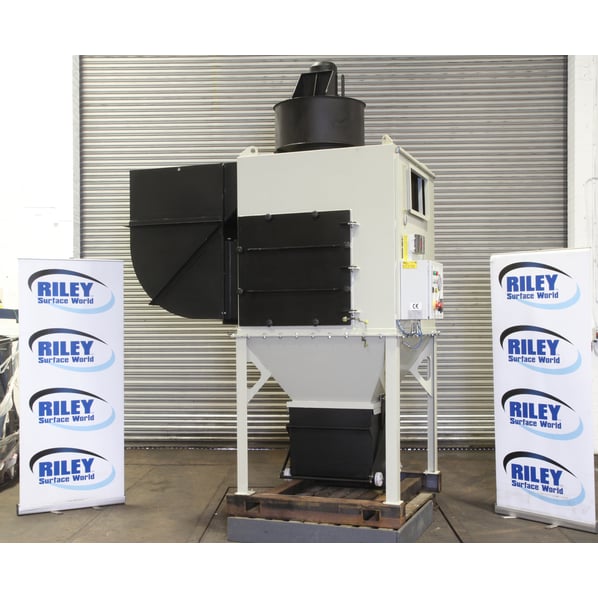J Reid Unused Very Heavy Duty Reverse Pulse Continuously Rated Dust Extraction Unit

- Stock No
- EC2100
- Manufacturer
- J Reid
- Model
- 3033
- Year of Manufacture
- 2008
- Serial
- 1335
- Condition
- Excellent Condition, Unused
- Approx Duty CFM / M³/Hr
- 3000 cfm // 5000M3/Hr
- Filter Area ft² / m²
- 1524 // 124M2
- Other Info
- ATEX Explosion Relief Panel
- Location
- Our Central Warehouse, Aldridge, UK
- External Dimensions (WxDxH mm) [?]
- 2520 x 1700 x 3410
- Delivery Your delivery options
Description
The reverse jet cleaning extractor is a continuous self-cleaning cartridge unit, this extractor can retain dust particles while allowing passage for free airflow in operation. It is designed for use in shot blasting environments and is fitted with a temperature checking thermocouple, Red Lion controller, and a fire extinguisher spray system.
Operation
- Dust laden air enters the inlet side of the extractor unit and is deflected downwards. This change of direction, together with a reduction in velocity, results in a high proportion of the dust being separated from the air stream reducing the load on the filter cartridges.
- In a reverse pulse jet system, a jet of compressed air is pulsed sequentially into the centre of the filter cartridges expanding the pleats of the filter material and dislodging the dust cake, which has become sufficiently heavy to fall through the air stream, into the lower portion of the collector.
- The control equipment also provides an over-run timer. When the fan has switched off the pulsing, cleaning of the cartridges will continue for a further “run on” period providing offline cleaning and conditioning of the cartridge filters.
Details
- Inbuilt fire extinguisher spray system
- Explosion relief panel with large up-scoop outlet
- 4kW / 5.5Hp 'AmTecs' fan motor at 2880 rev/min
- Inlet: 600mm x 300mm
- Outlet: 375mm x 375mm
- Waste bucket capacity: 160 Litres
- Cartridge size: Ø330 x 700mm long x 6 off
- Power Supply: 415v 50hz 3ph & N
Paint Specification: RAL 7032 QD enamel black matt
Filters: DBS-205FAS, 6 off
N.B
- Exception Large filter area to cope with high volume loading of dust particles.
How do Dust Extractors Work?
Dust collection systems work in a variety of different ways but all have general principles in common. They draw process dust and particulates from the air through a filter that first captures and separates the matter, and then discharges decontaminated air back into the workplace or environment.
Dust extractors are used in many different and varied industries and so different demands are made of them; however all have common components such as a blower (or fan), dust filter, filter cleaning system, dust container and dust removal system.
Five common types of dust collection equipment are fabric filter baghouses, inertial separators (like mechanical cyclones), cartridge collectors, wet scrubbers, and electrostatic precipitators.
Importance of Dust Extractors
Dust in the workplace can affect product quality and employee´s health. Having a dust-free environment is essential to the health and safety of the workforce. Not only does it affect the health of employees but the dust covers the equipment affecting production processes and quality of the products.
Capturing the dust at the source prevents it from spreading, done by using a dust extractor system to facilitate the important housekeeping to avoid it from accumulating.
Importance of Explosion Panels in a Dust Extractor
As extraction systems suck in air in concentrated volumes, the risk of explosive dust igniting is greater; therefore precautions are required to control the risk. A dust extractor with explosion panels installed will have these panels located in the areas where the dust is most likely to combust, controlling the explosion so it ignites in the area that has been constructed to withstand the impact without damaging the extractor itself.
Factors to Consider for Your Next Dust Extractor
When implementing the safety measures to ensure minimal risk to your workers, the factors to consider when purchasing your extraction unit/system are:
- Dust Source - Does the process that produces dust occur in an enclosed or open area?
- Capacity - Does the extractor have a large enough filter area required to handle the volume of dust?
- Type of Dust – Do you need an extractor capable of handling dust at risk of self-igniting?
- Maintenance – Would a self-cleaning extractor with an automatic shaker cycle be more suitable for you?
For further guidance, find out how to carry out your own COSHH (Control of Substances Hazardous to Health) risk assessment at the HSE website to help calculate your requirements.
What are Cartridge Dust Collectors?
Cartridge Dust Collectors a type of filter unit which is predominantly used in environments where space is at a premium. They can often maintain airflows which remain comparable to larger baghouse units.
Cartridge units provide larger fabric filter areas into a smaller place, use less filters and can be changed from the outside of the extractor, rather than having to access the unit internally, thus reducing filter replacement times and less environmental contamination issues for maintenance staff.
They are ideal for commercial and industrial environments, whose processes produce very fine-to- moderate dust-like powders, metalworking, woodworking, fume collection, thermal spraying, among other processes.
Photographs taken prior refurbishment. Our refurbishment service is not available on all machines.
Machines & equipment for sale
- Surface Treatment
- Cleaning & Degreasing
- Polishing & Belt Linishing
- Mass Finishing
- Ovens & Furnaces
- Process Cooling
- Shot Blasting
- Dust & Fume Extraction
- Air Compressors
- Rectifiers & Transformers
- Miscellaneous
- Latest Stock
- Special Offers
- Direct From Site Clearances
- Auctions
- Brand New Machines
- Available Immediately
- Sell Your Machine
Machine Alert
Get the latest machines emailed directly to you as they become available to buy online. Sign Up Now
















